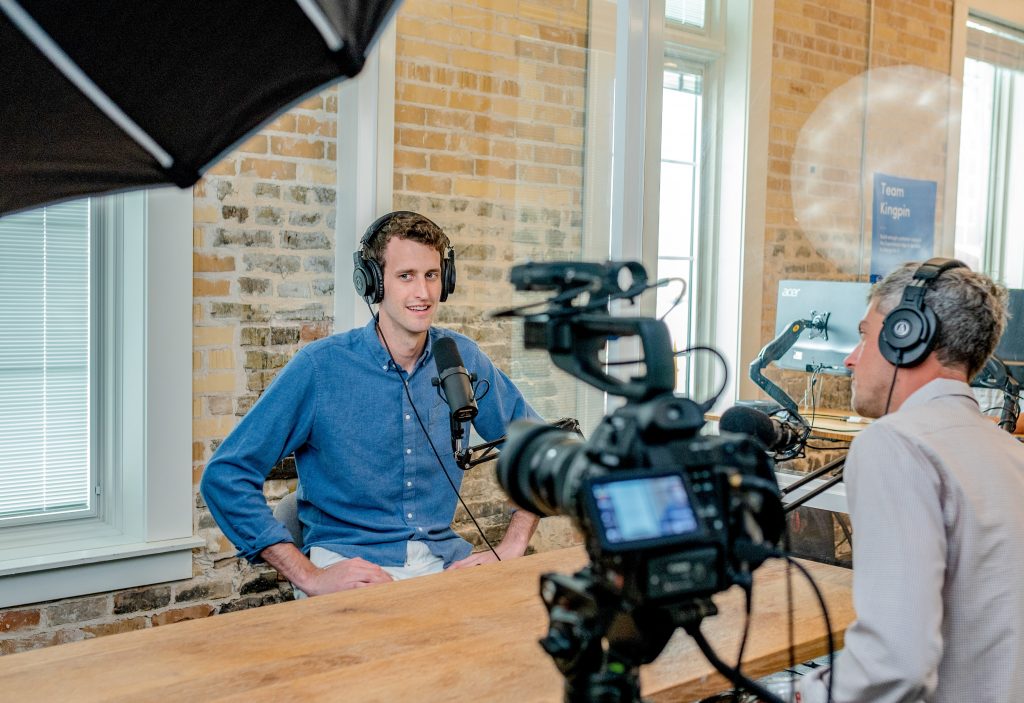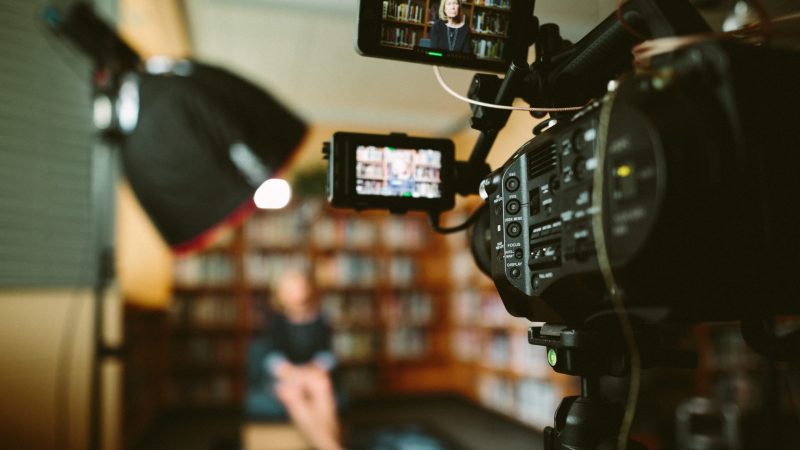Podcasts have long been an excellent vehicle for discussions, opinions and explorations of our favorite topics. The classic podcasting format consists of a host (or co-hosts) and often with guests that participate in each episode. These are usually audio-based, but does it mean that podcasts are limited to audio only? The answer was “yes” for years, but recently things have started to change towards more and more video based podcasts. Why should you limit yourself and your podcast to just one format? (or platform).
Here we’re going to look at the different ways you can boost your brand and audience by creating video podcasts:
- What is a podcast?
- Can podcasts have video?
- Starting a YouTube podcast
- Tools for video podcasting
So, grab your mics, and get your notes ready – it’s time to dive into video podcasting!
Aren’t podcasts audio only?
Traditionally, podcasts are audio files that can be listened to either in real time (streaming) or at any point after their release via podcast apps or podcast websites. Podcasts are a series of regular recordings of topic-specific discussions, performances or events shared in a series over online platforms. They’re are usually distributed via an open format called “RSS”, and these RSS feeds can be consumed by many apps or devices.
Podcasts are generally audio-only, but these days we’re seeing more and more podcasters using additional techniques and channels for better engagement, visibility and discoverability. The team at Apple say that “Podcasts usually offer each episode in the same file format, such as audio or video, so that subscribers can enjoy the program the same way each time.” And this is the key thing – keeping it in the same format and around the same topic. So, if you’re asking ‘Do podcasts have video?’ the answer is a definite yes. So long as the rest of the series is produced and formatted the same way and around the same subject.
Fun Fact: A video podcast is not necessarily a vlog. Vlogs aren’t always in a series or episodic – they typically deal with individual thoughts and ideas, much like video articles or blogs.
How can podcasts have video?
Many podcasters choose to distribute their podcast in multiple formats – audio, video and text. These can then be shared with different types of audience, over websites, podcast apps, streaming services (like YouTube or Vimeo), social networks, and more.
The kind of of video depends on what your topic is and how much you want to be on screen. Using video is a great idea for growing your podcast audience by adding extra content on your website and therefore attract more visitors. Re-purposing your podcast into different channels and formats can do magic in terms of growing your audience.
This isn’t very well known, but traditional podcast RSS feeds can actually have video distributed in them rather than audio. This is supported in many “podcatchers” like Apple Podcasts. (And fun fact – it’s fully supported by Podcastpage.io for a perfect experience for both audio and video)

Remote video podcasts
This kind of visual podcast is formatted as a conversation between multiple people in their own homes. In the past few years, dozens of new tools have emerged that should help you record a podcast remotely. This means you can record an episode with any guest or co-host, no matter if they live on the other side of the planet or just next door. You can record podcasts with multiple participants, and you can record both audio and video, or just audio if you prefer. You don’t always need to have proper recording studios, green screens, fancy cameras, or after effects, just your typical podcast audio gear with basic video equipment with an added camera. Sometimes a basic mic and a webcam can do the trick.
The quality definitely varies, and investing a little bit in good equipment is a good idea. One of the nicest things about video podcasts is that you can see physical reactions and enthusiasm. This visual link will create much better, more emotional connections with your audience because they can put a face to the voice.
The in-studio video podcasts
For a more professional, high-quality video podcast, there’s the in-studio option. This format is all about consistency. You can get everyone in frame and all the audio at the same level creating a sleek, expert video that requires very little editing. Looking at the Comedy Bang Bang! Video podcast hosted on Earwolf’s YouTube channel, you can see they’re all in the same room with the same professional equipment, but they’ve experimented with the framing and editing, getting close-ups, wide shots and reactionary footage too.
Doing it like this is more complicated to film due to the extra team members and video recording tech needed, and in post-production as well to cut it all together. But the camaraderie, fun and the banter you take part in face-to-face will ingratiate you with your audience more than ever. Another high-profile example is the Joe Rogan Experience podcast, where usually each episode is shipped with a video from the in-studio recording of Joe Rogan and his podcast episode guests.

The mixed-media video podcasts
This one is exactly what it says – a mix of interview footage cut with other media. It’s fairly popular in video game podcasts. A couple of examples of this include the Pretty Good Gaming Podcast which uses in-frame edits to show video game footage alongside the hosts. There’s also one from Off Book The Improvised Musical which focuses on one piece of video game footage with an in-frame video of the host.
With these, it’s key to remember how much more work there is in post-production. Especially if, like in the two above, the audio directly links to the additional footage – you’ve got to line it up to ensure consistency. But the audience will be able to better follow the story and trust you and your opinion.
Moreover, this kind of podcast can be a very useful tool if you have to start and stop your host audio for any reason – the additional footage can hide the visual cut while keeping the audio seamless.
By using this type of content, your listeners/viewers can get additional value during the episode. Much like a documentary movie that shows still photos or short clips from various resources. Your audience could become more and more engaged and not be distracted while consuming your episodes.
Starting a YouTube podcast
Podcasting on YouTube is probably the easiest place to start if you’re a beginner. It’s a very simple upload process and has a huge audience of over 2 billion users waiting to connect with you. Moreover, you won’t have to worry about video podcast hosting, as YouTube will do it for you. Their videos are easy to integrate into your podcast website too if you want to branch out and start monetizing.
YouTube is also an important tool as you can get lots of organic visitors to your episodes via YouTube, who either stumble upon your videos or see a direct link shared to one of your episodes.
It’s easy to create YouTube playlists for all of your podcast episodes, and there are tools that can automatically help you publish your content into multiple different channels whenever you release a podcast episode.
If you’re using Podcastpage.io to create a website for your podcast, it’s easy to embed YouTube videos in your episode pages. It’s very simple to give your audience more than one format, along with the podcast audio and podcast show notes.
Bonus: Sync a YouTube Channel with your website
With Podcastpage, we make it super easy to connect entire YouTube channels and playlists to your website. This connection is done automatically and we always keep your website in sync with all videos you have on your YouTube channel. Creating a website for your video-based podcast is a great idea, and it can help you grow your podcast or grow your YouTube channel as well.
Tools for video podcasting
There are many tools that can help you with creating a video for your podcast. We can divide the tools into two groups; the first one is video filming and the second one is converting your podcast into video clips (not necessarily videos of you). Here are the tools:
1. Video filming tools:
- Squadcast.fm – Squadcast is one of the most popular tools for podcasters who record podcasts guests who are located in a different room, city or country. They’re known for their high-end audio quality, even with a bad internet connection. Another big feature (at the time of writing, this feature is still coming soon) is built-in video recording that could really help you get going if you’re planning to record guests remotely.
- Riverside.fm – A relatively new player in the podcasting world, Riverside offers a pretty similar set of tools like Squadcast, with separate audio and video tracks you can export. They also allow real-time call-ins from listeners (that’s right, during the live recording of your podcast) that could be via audio and/or video, so that’s really a nice feature and can increase listener engagement by having them participate in the podcast itself.
- Loom – Loom is not really a tool for podcasters, but if you’re recording a podcast on your own, and want to display your screen (and an optional video stream from your camera) alongside the audio, it can be easily done. Loom is a very popular tool for screencasts, but it can still be used for podcasting.
- Twitch – Twitch is also not a native podcasting platform. It’s generally a platform for gamers or coders. However, many people use Twitch to record their screen while playing a game, developing software, or just creating a tutorial. If you include recorded audio, those recordings can all be used for podcasts with video.
2. Podcast video clip tools:
Many podcasters love to share a short clip of their weekly episode on social media. These clips became really popular over the past couple of years. The clips can include audio, subtitles, a static image and a dynamic waveform attached to your shared video clips. There are many solutions available in that space, here are a few:
- Headliner – video creation made easy: Bring your audio or video. Add captions, animations, images, gifs or videos. Export your video and share across social media.
- Wavve – take audio snippets from your podcast and turn them into shareable video highlights for social media.
- Audiogram – easily share short clips on social media with audio, text, and waveforms.
- Audioburst – Audioburst helps creators generate videos and transcripts.
Conclusion
Still not convinced if a podcast should have video? Here are a few pros and cons of video podcasting:
Pros:
- You’ll be able to share your emotions and reactions, further endearing you to your listeners.
- YouTube can also brings more organic traffic, encourage discussion, and shares.
- You’ll gain listeners trust as they will be able to see you and your guests – it builds credibility.
- Clips are great for cross-platform promotion.
- Publish your content in different formats/mediums for more exposure.
Cons:
- More equipment and software = higher costs.
- More editing = more time.
- If you make a mistake, then you can’t just edit it out unless you’re doing a mixed-media podcast.
- No more lazy PJ’s recording – unless that’s your vibe.
- Not everyone is comfortable in front of a camera.
- Video podcasts aren’t as easy to consume on the go.
At the end of the day, podcasting is what you make of it. We don’t say all podcasts should have video, but we also don’t think podcasts are strictly audio-only.
It’s up to you to decide which mediums work best for your podcast. You can publish your episodes in the way that works best for you, for your show and for your audience. Beyond the podcast audio, you can include video, transcripts, downloads/attachments and more. Interested listeners and viewers will find you either way. But with that said you can increase your chances by creating more formats and re-purposing your podcasts into multiple channels.
A video-podcast would help in visualizing things, showing people’s reactions and body language. It also adds the ability to include mixed content like images, documents or other clips in your show.
If you’re building a website for your video podcast – check Podcastpage.io. It’s the best YouTube website builder for audio and video creators.



